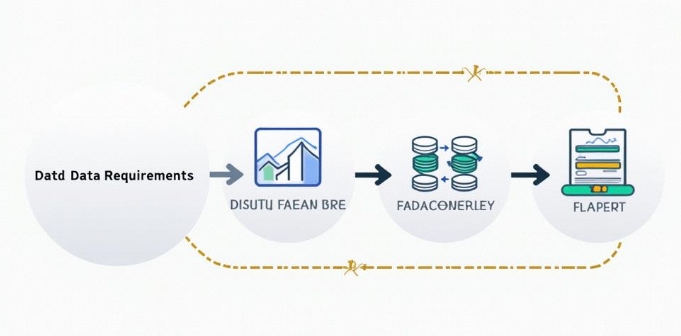Machine Learning Development and Design: How to Build an Efficient Intelligent System from Scratch
- latest articles
- 1.DApp Development & Customization: Merging Diverse Market Needs with User Experience 2.Analysis of the Core Technical System in DApp Project Development 3.How to achieve cross-chain interoperability in Web3 projects? 4.How does the tokenization of points reconstruct the e-commerce ecosystem? 5.How to Set and Track Data Metrics for a Points Mall? 6.What is DApp Development? Core Concepts and Technical Analysis 7.Inventory of commonly used Web3 development tools and usage tips 8.Development of a Distribution System Integrated with Social E-commerce 9.Six Key Steps for Businesses to Build a Points Mall System 10.What is DApp Development? A Comprehensive Guide from Concept to Implementation
- Popular Articles
- 1.Future Trends and Technology Predictions for APP Development in 2025 2.Analysis of the DeFi Ecosystem: How Developers Can Participate in Decentralized Finance Innovation 3.From Zero to One: How PI Mall Revolutionizes the Traditional E-commerce Model 4.DAPP Development | Best Practices for Professional Customization and Rapid Launch 5.Recommended by the Web3 developer community: the most noteworthy forums and resources 6.From Cloud Computing to Computing Power Leasing: Building a Flexible and Scalable Computing Resource Platform 7.How to Develop a Successful Douyin Mini Program: Technical Architecture and Best Practices 8.Shared Bike System APP: The Convenient Choice in the Era of Smart Travel 9.How to Create a Successful Dating App: From Needs Analysis to User Experience Design 10.From Design to Development: The Complete Process of Bringing an APP Idea to Life
With the rapid development of artificial intelligence, machine learning (ML) has become a key force driving technological innovation and business growth. Whether in healthcare, finance, retail, autonomous driving, or smart homes, machine learning has demonstrated immense potential. Building an efficient intelligent system is a challenge faced by every machine learning developer. How to design a machine learning system from scratch and ensure its efficiency and scalability has become an urgent problem for developers and engineers to solve.
This article will detail how to build an efficient machine learning system from scratch, covering key steps such as data collection, data preprocessing, model design and selection, performance optimization, and deployment. By deeply analyzing each stage of the machine learning development process, it will help you understand how to design an efficient and maintainable intelligent system from the ground up.
I. The Fundamental Framework of Machine Learning Development
Building an efficient machine learning system is not a simple process but a complex, multi-stage development effort. Typically, this process includes data collection and preparation, feature engineering, selecting the appropriate model, training and optimizing the model, and finally, system deployment and monitoring. Below, we will delve into these key steps one by one.
1. Data Collection and Preparation
The foundation of a machine learning system is data, and the quality of the data directly determines the model's performance. Collecting and preparing data is the first step in building any machine learning system. A good dataset helps build an accurate and efficient model, while a poor dataset may cause the model to malfunction.
Data Collection: First, determine what data your system needs. For different types of machine learning tasks, the type and source of data vary. For example, in a speech recognition system, you need audio files and corresponding text labels; in an image recognition task, you need clearly annotated image data.
Data Cleaning: After collecting data, data cleaning is the next critical task. Data cleaning includes removing duplicates, handling missing values, correcting outliers, etc. Data that hasn't been effectively cleaned may lead to bias and inaccuracies in model training.
Data Standardization: Different data features may have different scales, causing some features to be overemphasized or underemphasized during model training. Standardization (or normalization) is a method to convert data to the same scale, commonly using Z-score standardization or Min-Max normalization.
Data Augmentation: For specific tasks (such as image classification, object detection, etc.), data augmentation techniques can increase data diversity. Data augmentation can involve methods like rotation, translation, and cropping, effectively improving the model's generalization ability.

2. Feature Engineering
Feature engineering refers to the process of extracting useful information from raw data. Good features help machine learning models capture underlying patterns in the data, improving model accuracy and efficiency. The feature engineering process typically includes the following aspects:
Feature Selection: Feature selection involves screening the most representative and informative features from a large amount of raw data. By eliminating redundant features, computational complexity is reduced, and model stability is improved.
Feature Extraction: For certain tasks (such as text classification or image recognition), we need to convert raw data into feature vectors using feature extraction methods. For example, in text processing, TF-IDF or Word2Vec methods can be used to convert text into numerical representations; in image processing, convolutional neural networks (CNNs) can automatically extract image features.
Automation of Feature Engineering: In recent years, automated machine learning (AutoML) technology has become increasingly popular, automating the process of feature selection and feature engineering, significantly reducing manual complexity.
3. Model Selection and Training
Once the data is ready, the next step is to select the appropriate machine learning model. Different tasks and data types require different algorithms and models. Common machine learning models include:
Linear Regression: Suitable for regression problems, predicting continuous numerical target variables.
Support Vector Machine (SVM): Suitable for classification problems, especially effective with high-dimensional data.
Decision Trees and Random Forests: Suitable for classification and regression tasks, offering good interpretability, especially with complex data.
Neural Networks: Suitable for large-scale datasets and complex pattern recognition problems, such as image, speech, and text processing.
k-Nearest Neighbors (KNN): Suitable for classification problems, often used with small datasets.
Model Training: After selecting the appropriate algorithm, the training phase begins. Training involves comparing input data with target data and adjusting model parameters to minimize the loss function. During training, optimization algorithms like gradient descent are often used to update model parameters.
Cross-Validation: To ensure the model's generalization ability, cross-validation (such as K-fold cross-validation) is widely used during the training phase. By dividing the data into multiple subsets for training and validation, the risk of overfitting is reduced.
II. Model Optimization and Evaluation
Model optimization is a critical step to ensure the efficiency and accuracy of a machine learning system. The goal of optimization is not only to improve the model's predictive ability but also to ensure that training and inference times are within acceptable limits.
1. Hyperparameter Tuning and Optimization
Each machine learning algorithm has its own hyperparameters, and selecting the right hyperparameters is crucial for model performance. For example, in support vector machines, C and the kernel function are two important hyperparameters; in neural networks, learning rate and batch size are hyperparameters that need optimization.
Common hyperparameter optimization methods include Grid Search, Random Search, and Bayesian Optimization. These methods help quickly find suitable hyperparameter combinations to improve model accuracy.
2. Model Evaluation and Performance Metrics
After training and optimizing the model, evaluating its performance is a crucial step. Commonly used performance evaluation metrics include:
Accuracy: Used for classification tasks, representing the proportion of correct predictions.
Precision and Recall: Used for imbalanced datasets, measuring the model's ability to accurately predict positive classes.
Mean Squared Error (MSE): Used for regression tasks, measuring the difference between predicted and actual values.
AUC-ROC: Used to evaluate the performance of binary classification models, especially in cases of class imbalance.
Additionally, considering the model's practical application scenario, it's necessary to evaluate inference speed, memory usage, and scalability.
III. Model Deployment and Monitoring
Once the machine learning model is developed, the next step is to deploy it into a production environment. Successful deployment is not just about placing the model on a server but ensuring it can efficiently and stably serve users.
1. Model Deployment
When deploying a model, it is typically converted into a callable API, providing services through RESTful interfaces. Docker container technology can be used to package the model and deploy it to the cloud or local servers, ensuring the model runs smoothly in various environments.
Furthermore, after deployment, container orchestration tools (such as Kubernetes) may be needed to manage multi-instance deployment and load balancing to handle high-concurrency requests.
2. Model Monitoring and Maintenance
Once the model is deployed, monitoring becomes crucial. Monitoring involves not only checking if the model is running normally but also assessing its performance on real-world data. If the model's performance degrades on new datasets (known as concept drift), the model needs to be retrained.
Additionally, model maintenance and updates are part of the developer's responsibilities. Regular monitoring and updating ensure the model adapts to new data and changing business needs.

IV. Conclusion
Building an efficient machine learning system is a complex and challenging task. From data collection and preparation to model training, optimization, and deployment, each step requires developers to have solid foundational knowledge and practical experience. In this process, besides the technology itself, understanding business requirements, continuously optimizing model performance, and monitoring and maintaining the model's performance are equally important.
As technology continues to evolve, machine learning will play an increasingly important role across various industries. We hope this article provides you with a systematic framework to help you design and build an efficient machine learning system from scratch.
-

How does artificial intelligence technology transform the operational models of modern enterprises?
In the wave of the digital era, artificial intelligence (AI) technology has tran···
-

How to Utilize Artificial Intelligence for Precision Medicine and Health Management
With the rapid advancement of technology, artificial intelligence (AI) has demon···
-

Integration and Application of Artificial Intelligence and Robotics
In today's era of rapid technological advancement, the integration of artificial···

 Blockchain
Blockchain










